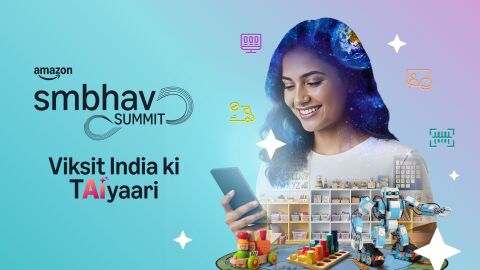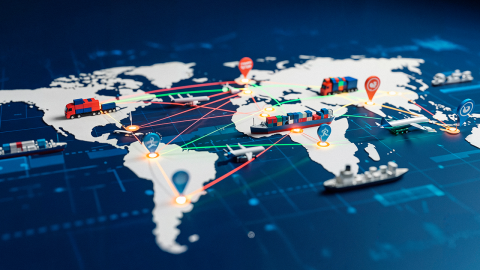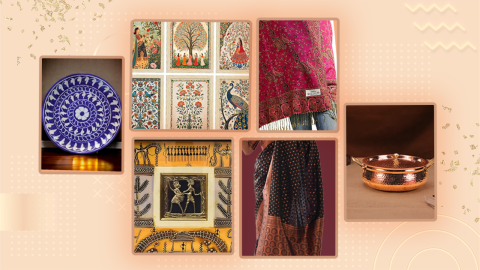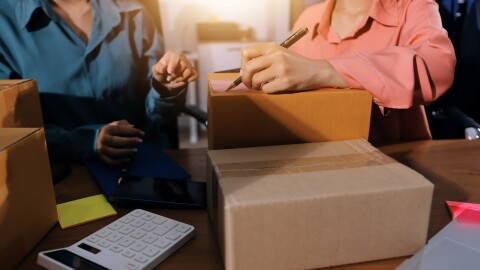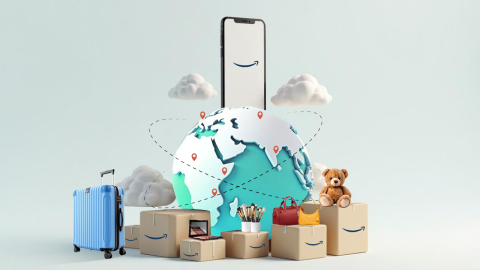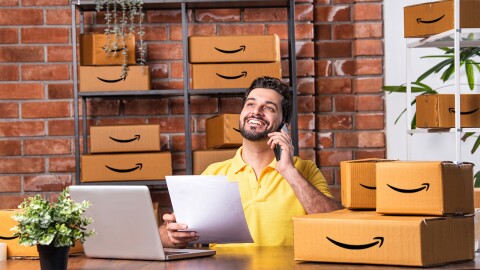On Day 1 of Amazon Smbhav 2022 there was an exciting fireside chat on exports with the theme ‘Scaling India's role in global supply chains and building global brands from India,’ that was hosted by Abhijit Kamra, Director- Global Trade, Amazon India. Joining him was Eric Broussard, Vice President, International Marketplaces and Retail at Amazon. Based in Seattle, Washington, Eric leads Amazon's international marketplace business in Europe, Japan, China, and Australia, as well as all our cross-border initiatives worldwide. The second speaker was Dr. Montek Singh Ahluwalia, the former deputy chairman of India's Planning Commission, renowned economist, and Padma Bhushan awardee. Mr. Ahluwalia’s roles have ranged from being the first director of the Independent Evaluation Office at the IMF to being the youngest division chief of the World Bank. Welcome, Dr Ahluwalia.
Speaking on the occasion Abhjijit said, "As India moves towards the ambition of becoming an exports superpower, we believe that embracing technology and e-commerce will be integral to unlocking India's exports potential and creating truly global brands from India. Every day at Amazon, we see how technology and e-commerce are helping lower the entry barrier for lakhs of MSMEs and entrepreneurs to expand their horizons and serve customers not only in India but across the world. Amazon Global Selling was launched in 2015 and has quickly grown to over one lakh exporters, which include marquee Indian brands, as well as digital-first brands. Encouraged by the momentum that the program is witnessing, we have scaled up our commitment to boost exports from the country and have taken a pledge to enable $20 billion in cumulative exports from India by 2025."
Excerpts from the chat:
Abhijit Kamra: I'm excited to introduce two very distinguished guests an let's dive straight into the questions we have for you today. Let me get started with you, Dr Ahluwalia. We are emerging from two years of tremendous uncertainty, into what looks like a period of rebuilding and rejuvenating the economy. What role do you see exports as a sector playing as India looks at enhancing its position in the global economy?
Well, as you say, I mean, like other countries, we are kind of emerging from a pretty bad position in the previous year, because of the pandemic. And I mean, like the rest of the world, we are also swamped with uncertainty about what's going to be the impact of Russia and Ukraine in the years ahead. So quite honestly, I think the biggest thing about the year ahead is uncertainty.
There's no question in my mind that exports, they're important in two ways. One is that we do need, in my view, to keep giving importance to exports. You know, for many years, as we moved into an open economy, exports did quite well. Then for several years, they began to stagnate and even decline. This last year, they picked up again, which is very good. But I think they have to go a lot higher. And therefore, from India's point of view, it's a measure of whether India is doing well, that is actually exporting. A part of the problem here is that India also imports crude oil and export products. That can lead to exaggerated estimates of what's happening on the export front, particularly when prices go up. Do you get what you pay a lot for imports, and then you make another few per cent on it when you export. But I think, exports have done well, even if you keep out oil, so that part of the story is good. We need to keep watching it because I think everybody will be both internally and externally looking at whether India's gaining credibility and competitiveness in the export market.
I have no doubt that if Amazon actually puts out an aggressive export target and delivers it, that would be counted as a very positive development.
I think when it comes to, particularly the role of global players like Amazon, I mean, people are aware that Amazon can provide a platform for Indian exporters, MSMEs, in order to access markets that are otherwise difficult to get to. So, I have no doubt that if Amazon actually puts out an aggressive export target and delivers it, that would be counted as a very positive development. I mean, there will be people who will want to say, have you simply sort of diverted? What was being exported without the Amazon platform to being exported through the Amazon platform? Those kinds of questions can't be answered. But the important thing is, if the platform is actually onboarding a number of MSMEs, and producing a lot of exports, that will certainly count as a very positive thing.
Abhijit Kamra: Thank you, Dr Singh. Eric, building on Dr Singh's last observation, what kind of capabilities has Amazon built through this pandemic to serve customers across the world? I ask this question specifically in the context of the goal we've taken to enable $20 billion of cumulative exports from India by 2025?
Eric Broussard: Thank you. I'd like to start by talking about the recent past of Amazon, and how Amazon's rules evolved tremendously. I mean, the unprecedented challenges the world has seen over the last few years. As you know, no one really had a playbook to deal with the disruption we really experienced. As most physical venues closed, millions of people came to Amazon relying on Amazon, to get PPE, food, clothing, and various other items. It was a really a tremendous change in the demand curve, that we ended up experiencing. What we had to do was scale up very quickly our capabilities to serve that demand. And what really helped us for the many, many years before the pandemic, where we built infrastructure across the world, to be able to scale it up, and really transform our ability to deliver products and services to our partners and customers.
To give you an example, it used to take us over 18 hours to fulfill an item, meaning from the time we'd get the order to the time it would be on the truck, it would take 18 hours. Today, it takes us two hours. That's the type of improvements we've made to be able to fulfil the demand. Millions of partners, small sellers, medium sellers, and large sellers, rely on us to deliver their products. So this is not only a set of investments available to Amazon, these investments we make are available to all our partners across the world. And that infrastructure is so critically important to enable the exports Dr Ahluwalia just talked about.
Abhijit Kamra: Thank you for that perspective, Eric. Dr. Ahluwalia, now coming back to you, as somebody who's seen India's evolution and development so closely, what do you think are some of the fundamental strengths we have and what are some of the important steps that we need to take to encourage exports from our country?
Montek Singh Ahluwalia: Well, I mean, obviously, one of the strengths that you have, is that you're a platform that's known around the world. So, from any Indian exporter's perspective, there are other exporters now through the net, who can reach out to people in many, many different ways. There's no question that if somebody wants something, and they go to Amazon and plug in what they're searching for, then a whole lot of products come up. If a whole lot of Indian products also come up, that's a very major game. And I think that is what you bring to the table, which at least at the moment, nobody else brings because elsewhere in the world, there you have some competitors domestically, but they're not internationally known as yet. So, you're the biggest, the special advantage that you have is to give Indian exporters a platform which the world is familiar with. And the question is, are they using it? Are you helping them to use it? Certainly, if you measure what's coming out of that platform in terms of orders directed to these guys, that will, as it were, resound very positively in public perception as a contribution of Amazon, I'm not counting your contribution to consumers. Because I mean, after all, if you're making a huge contribution to Indian consumers. But you're talking about exports here, and not just e-commerce generally.
Abhijit Kamra: Got it. Thank you, Dr. Ahluwalia. Eric, you talked about investments in logistics and technology. What does it really mean for Indian businesses? You have been interacting with Indian entrepreneurs for a very long time, and then seeing how exports from India have shaped up? What do you see that's different now versus what was let's say, a decade ago, or 15 years ago?
Eric Broussard: I mean, if you think of where we were maybe 10-20 years ago, if you were a small or large entrepreneur from India, and wanted to reach customers outside of India, you had a long journey in front of you. You might have had to go to trade fairs, find partners, or build local logistics in each of the countries you wanted to go to. There were at the end of the day, many intermediaries between your brand, your product, and the end customer. And in a lot of instances, you never really had a brand, you were relinquishing the control of your product, the image, the marketing, the pricing of that product, to a large number of partners. Today, Amazon makes the world much smaller, a fair marketplace for everyone, no matter what your size, and provides you with the ability to reach customers directly. And that's really crucial. What it means is that, if you're, for example, a toy seller from India, and you want to deliver products and sell and build a brand in Europe, or in the US or in Japan, you can do so directly by leveraging the infrastructure. I talked about it earlier, and that's really transformative. Because this is no longer again relinquishing, as I mentioned, the control of your product. This is really reaching the customers directly. And that's really where technology is massively transformative.
Abhijit Kamra: Thanks Eric, for that perspective. Dr. Ahluwalia let's talk about brand India now. What's your view on the kind of ecosystem we need to create to build global brands from India? We all know that we have great products that are manufactured in India. But how do we put the global Indian brands there?
Dr. Montek Singh Ahluwalia: Well, it's not my area of expertise, how you do that, but I can certainly agree with the basic proposition that a lot of people produce good products, to tie up with foreign brands to market them as their products. And about all, you see in that, whether it's a bed sheet or a bit of clothing or something you see with a “made in India” label inside, you don't actually promote the brand. I mean, there's no question and what I think Eric was saying is that if you can have a system where somebody is searching for a product on an e-commerce website, like Amazon, and you search for whatever, and out of that comes an Indian branded product, with all sorts of descriptions, etc, and people start buying it, you know, you have promoted the brand. I mean, the earlier notion of promoting the brand India was very much, you know, having huge fans and going to trade fairs and putting up pavilions, and within their products, etc. And that very old-fashioned kind of concept, because now you can presumably directly approach customers. I mean, you know, the idea that you have to approach 200 people who will turn up at a particular trade fair, is giving way to the idea of using it in order to reach out directly to customers. And I think that's very important, but it's a complete game-changer. Whether, or how we exploit it is not in my technical remit. I don't know how to do that. But I can see as an economist that if somebody was advising someone, look, this is the best way of doing it. I mean, we will soon work out what works and what doesn't work. I mean, the brand issue is very important because you know, at least when I lived in the United States, if you went down to one of those brick-and-mortar grocery stores, there would be a thing saying Indian spices they'd all be McCormick brand. You will not find on the stalls any Indian spice brand arrow. Maybe in the case of basmati rice, you might find something which was actually packaged in India. But even that was actually rare. So, if you can change that, that makes a big difference.
Abhijit Kamra: Eric, let me ask you a similar question, how do you see the customer response for made in India brands now? And what is driving this? And what are some of the fast growth categories from India on Amazon globally?
Eric Broussard: I mean, the short answer is that the demand is very good. The demand is very good, because the products are great. India's manufacturing base is really great as a country - across a large number of categories, from jewelry to home products to toys, all these categories have a really big potential. And because we now enable these manufacturers to go directly to consumers, customers react. And this is not at all only about the Indian community in the US or in Europe or wherever it may be. It's about any customer, that's on Amazon. As Dr. Ahluwalia said, who comes and start searching for products are the products that are coming directly from these brand owners, they are in control, they can list a product or thousands of products, they can decide how to price, they can decide how to advertise, they obviously choose and know how to market their brand. So that combination, you know, leads to a lot of demand because these products are very good value. The ability to be direct from the manufacturer or the brand owner to the consumer creates a lot of value. It also enabled the brands to learn very quickly because they're getting feedback from the customer base directly. You know, one example, Vahdam Teas, which is one of our sellers. Their products were part of the 2022 Oscars goodie bag. They were a couple years ago part of Oprah's favourite things, which as you know in the US is a sign of a brand that really has made it, in terms of its reputation and its integration into the US perception of what a brand might be. So, it's not the only one you know, I picked one example. But there are many, many examples. And in many, many ways, we're always saying, it's day one. I think it's very much day one where the opportunity is here. You know, people can seize it today and really expand their business and build their brands.
Abhijit Kamra: Thank you, Eric, very bullish positive thoughts for Indian brands. I'm at the end of our conversation. So, Dr. Ahluwalia would love to get your concluding thoughts. When do you think, India is going to become one of the leading exporters in the world? And what according to you are the top three things we must do as a country to help accelerate the growth Eric and you were talking about?
Dr. Montek Singh Ahluwalia: You know, we have a very long way before we can be what you call one of the leading exporters in the world. And then remember, our share of world trade is pretty low. So, I think rather than position ourselves as when are we going to be one of the leading exporters, I think we need to position ourselves when we get back to a more dynamic export performance than we've had for a set of years. And I think the most important thing to my mind is, first of all, clearly having good products and being competitive- which is critical. Some questions can be raised on how important it is to remain open and you know, my view is that you gain competitiveness if you remain open. So, I think that India needs to be more open not just in order to export but personally, I think we need to be more open also to the inputs. I mean the only way Indian exporters will actually know what is good quality is when Indian consumers also have a chance to see good quality products.
This is a large country, so a lot of the manufacturers are really exploiting the domestic market, tapping the domestic market, and then using that strength also to export. Sure, there are some areas like Jewelry and so on, where you have practically 100% export efforts. But if you're talking about manufacturing and so on, it's a much broader range of things and the quality of what is sold domestically. And the pressure that the domestic market puts on increasing quality is a very important part of becoming successful in exports. So, I just hope that we will retain that and keep watching our exports performance. I mean, the real point is that it's relatively easy for many exporters to simply tap the domestic market and say you're producing more because you're substituting for imports. It's only when you export, that you're really demonstrating that you're competitive because then you're exporting against world competition. So, I think that, for us to become a leading exporter, we have to become a much bigger country in terms of GDP. But well, before that, we could have a situation where our growth rate is high, and export growth is even higher. And if you can do that, I think that'd be pretty good.
Abhijit Kamra: Thank you. Thank you very much, Dr. Singh. Eric, you've seen business owners, sellers, MSMEs, from across the world grow using Amazon. What would be your advice for all the entrepreneurs and business owners in the audience who aspire to build global brands from India?
Eric Broussard: Yeah, and I was really thinking about what Dr. Ahluwalia was just saying, it really resonated with me. It is like, you know, we say on Amazon, start with a customer and work backwards. And that's the way your products become competitive in the world. Competition you were describing, and that's what I would say is that, if you're an entrepreneur, if you're an innovator, if you're a manufacturer, really focus on understanding the customer and what the customer needs. And again, you know, the Amazon systems and the processes we've put in place enables you to do that, because the feedback you directly get from the customers, that's invaluable. So really focusing on that end-customer, evolving the product, evolving the pricing, evolving your marketing, is really one should do at a very good level of detail. So that you know, your product can evolve. The second thing is to focus on product quality, really ensure that as you do that, as you learn from your customer, you transfer that into building great products. This is really what our partners or sellers from India are doing so well. So that these products can then get great customer reviews and word-of-mouth and really contribute to building a business. And lastly, I would say think globally. So don't only think about the Indian domestic market, don't only think about the US but really start thinking about how you're going to build a global brand, as we enable you to do so at very low cost. And that's going to enable your business to grow and be faster and more quickly, which again, you will benefit from the scale you're creating, and drive more investment and more profitable business more quickly. So, these will be the three things I would say start with a customer and focus on the customers build fantastic products and think globally by leveraging all the services and infrastructure we build across the world.
Abhijit Kamra: Thank you. That's great actionable advice for everybody out here who's listening and wants to build a global brand from India. With that, we come to the end of this very engaging fireside chat. Thank you very much, Dr. Ahluwalia, and Eric, for joining us today, here at Smbhav 2022 and sharing your thoughts with us. I would also like to thank everyone who's logged in to be part of the session. Stay tuned lots more coming your way in Amazon Smbhav 2022. Thank you everyone and have a great day.



